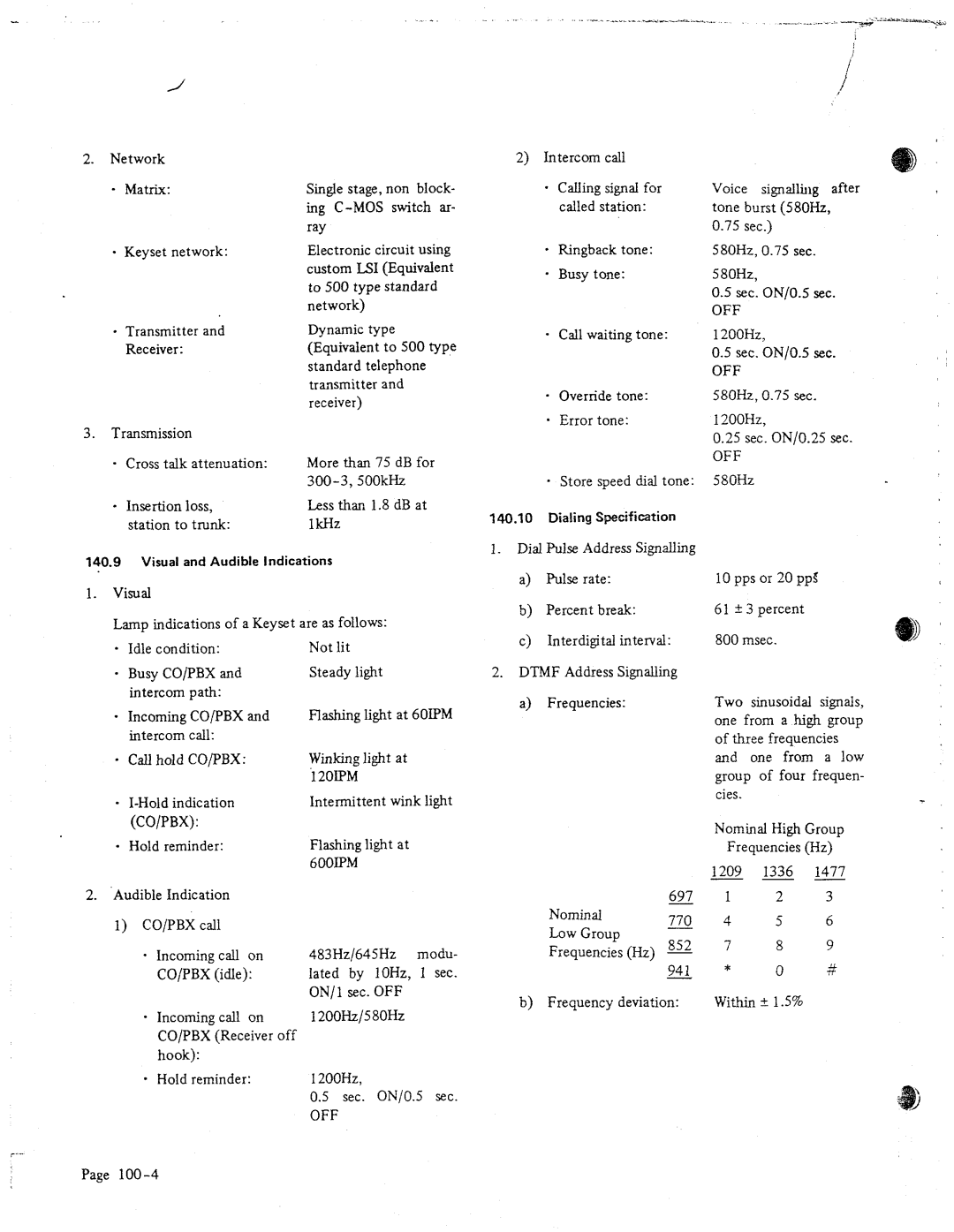
2.Network
-Matrix:
. Keyset network:
- Transmitter and Receiver :
3.Transmission
Single stage, non block- ing
Electronic circuit using custom LSI (Equivalent to 500 type standard network)
Dynamic type (Equivalent to 500 type standard telephone transmitter and receiver)
2)Intercom call
-Calling signal for called station:
*Ringback tone:
-Busy tone:
-Call waiting tone:
- | Override tone: |
- | Error tone: |
Voice signaIling after tone burst (580Hz,
0.75sec.) 580Hz,O.75 sec.
580Hz,
0.5sec. ON/OS sec.
OFF
1200Hz,
0.5sec. ON/O.5 sec.
OFF
58OHz, 0.75 sec.
1200Hz,
0.25 | sec. ON/O.25 sec. |
OFF |
|
-Cross talk attenuation:
-Insertion loss,
station to trunk:
140.9Visual and Audible
More than 75 dB for
Less than 1.8 dB at
IkHZ
Indications
* Store speed dial tone: |
140.10Dialing Spxification
1. Dial | Pulse | Address Signalling |
a) | Pulse | rate: |
580Hz
10 pps or 20 ppS
1.Visual
Lamp indications of a Keyset are as follows: |
| |||||
* | Idle | condition: | Not lit |
|
| |
- | Busy | CO/PBX and | Steady | light |
| |
| intercom | path: |
|
|
| |
- | Incoming | CO/PBX and | Flashing | light | at 601PM | |
| intercom | call: |
|
|
| |
* Call hold | CO/PBX: | Winking | light | at | ||
|
|
|
| ‘120IPM |
| |
- | Intermittent | wink light | ||||
| (CO/PBX): |
|
|
| ||
* | Hold | reminder: | Flashing | light | at | |
|
|
|
| 6OOIPM |
| |
2.Audible Indication
I)CO/PBX call
- | Incoming | call | on | 483Hz/64SHz | modu- | |||
| CO/PBX | (idle): |
| lated | by | lOHz, | 1 | sec. |
|
|
|
| ON/1 sec. OFF |
|
| ||
* | Incoming | call | on | 1200Hz/580Hz |
|
| ||
| CO/PBX | (Receiver | off |
|
|
|
| |
| hook): |
|
|
|
|
|
|
|
* | Hold reminder: |
| 1200Hz, |
|
|
| ||
|
|
|
| 0.5 | sec. | ON/O.5 | sec. | |
|
|
|
| OFF |
|
|
|
|
b) | Percent break: | |
c) | Interdigital | interval: |
2. DTMF Address | Signalling | |
a>Frequencies: |
| |
69J
Nominal770 Low Group Frequencies (Hz) 852
w*
Frequency deviation:
61 t 3 percent
800 msec.
Two sinusoidal signals, one from a high group of three frequencies
and one from a low group of four frequen-
cies.7
Nominal High Group
Frequencies (Hz)
1209 | 1336 | 1477 |
|
| |
1 | 2 | 3 |
4 | 5 | 6 |
7 | 8 | 9 |
| 0 | # |
Within | * 1.5% |
|
Page
